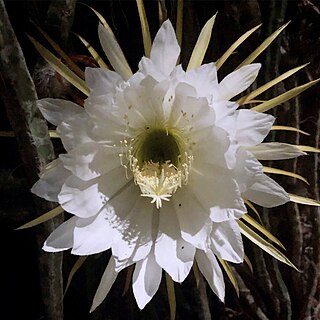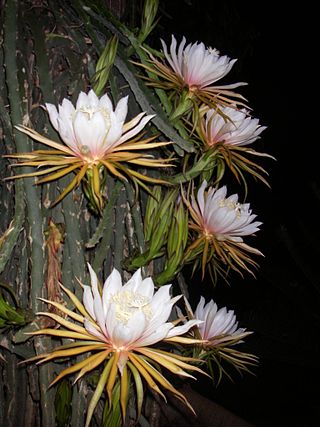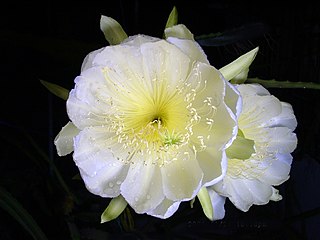
Night-blooming cereus is the common name referring to many flowering ceroid cacti that bloom at night. The flowers are short lived, and some of these species, such as Selenicereus grandiflorus, bloom only once a year, for a single night, though most put out multiple flowers over several weeks, each of which opens for only a single night. Other names for one or more cacti with this habit are princess of the night, Honolulu queen, Christ in the manger, dama de noche, and queen of the night.

Epiphyllum is a genus of epiphytic plants in the cactus family (Cactaceae), native to Central America and South America. Common names for these species include climbing cacti, orchid cacti and leaf cacti, though the latter also refers to the genus Pereskia.

Hylocereus is a former genus of epiphytic cacti, often referred to as night-blooming cactus. Several species previously placed in the genus have large edible fruits, which are known as pitayas, pitahayas or dragonfruits. In 2017, a molecular phylogenetic study confirmed an earlier finding that the genus Hylocereus was nested within Selenicereus, so all the species of Hylocereus were transferred to Selenicereus.

Selenicereus, sometimes known as moonlight cactus, is a genus of epiphytic, lithophytic, and terrestrial cacti, found in Mexico, Central America, the Caribbean and northern South America. The term night-blooming cereus is also sometimes used, but this is also used for many night-blooming cacti, including Epiphyllum and Peniocereus. In 2017, the genus Hylocereus was brought into synonymy with Selenicereus. A number of species of Selenicereus produce fruit that is eaten. The fruit, known as pitaya or pitahaya in Spanish or as dragon fruit, may be collected from the wild or the plants may be cultivated.

Selenicereus undatus, the white-fleshed pitahaya, is a species of the genus Selenicereus in the family Cactaceae and is the most cultivated species in the genus. It is used both as an ornamental vine and as a fruit crop – the pitahaya or dragon fruit.

The Cactoideae are the largest subfamily of the cactus family, Cactaceae, and are widely distributed throughout the Americas. Cactaceae is the 5th most endangered plant or animal family evaluated globally by the International Union for Conservation of Nature. Around 80% of cactus species belong to this subfamily. The genera of the Cactoideae are characterized by microscopic foliage leaves. All photosynthesis occurs in shoot cortex cells covered by a persistent epidermis and stomata. Another important characteristic of this subfamily is ribbed stems, which enable the inner cortex to expand radially without breaking the shoot surface to absorb large quantities of water.

Selenicereus megalanthus, synonym Hylocereus megalanthus, is a cactus species in the genus Selenicereus that is native to northern South America, where it is known, along with its fruit, by the name of pitahaya. The species is grown commercially for its yellow fruit, but is also an impressive ornamental climbing vine with perhaps the largest flowers of all cacti.
Bipolaris cactivora is a plant pathogen causing cactus stem rot and pitaya fruit rot.

Praecereus is genus of cactus. It is sometimes included in the genus Cereus.

Strophocactus brasiliensis is a species of cactus also known by its synonym Pseudoacanthocereus brasiliensis. It is endemic to Brazil. Its natural habitats are tropical and subtropical dry broadleaf forests and savanna. It is threatened by habitat loss.

Selenicereus grandiflorus is a cactus species originating from the Antilles, Mexico and Central America. The species is commonly referred to as queen of the night, night-blooming cereus, large-flowered cactus, sweet-scented cactus or vanilla cactus. The true species is extremely rare in cultivation. Most of the plants under this name belong to other species or hybrids. It is often confused with the genus Epiphyllum.

A pitaya or pitahaya is the fruit of several cactus species indigenous to the region of southern Mexico and along the Pacific coasts of Guatemala, Costa Rica, and El Salvador. Pitaya is cultivated in East Asia, South Asia, Southeast Asia, the United States, the Caribbean, Australia, Brazil, and throughout tropical and subtropical regions of the world.

The Hylocereeae are a tribe of cacti. Most are found in the tropical forests of Central and northern South America, and are climbers or epiphytes, unlike most cacti. The tribe includes between six and eight genera in different circumscriptions. The plants known as "epiphyllum hybrids" or "epiphyllums", widely grown for their flowers, are hybrids of species within this tribe, particularly Disocactus, Pseudorhipsalis and Selenicereus, less often Epiphyllum, in spite of the common name.

Selenicereus monacanthus, synonym Hylocereus monacanthus, is a species of plant in the family Cactaceae. It is native to parts of Central America and South America.

Strophocactus wittii, synonym Selenicereus wittii, known as the Amazon moonflower, is a species of plant in the genus Strophocactus in the cactus family (Cactaceae), and is one of several species commonly called "moonflowers". It was first described in 1900 by Karl Moritz Schumann and is one of three species of cactus found in the central Amazon basin.
Strophocactus sicariguensis, synonym Pseudoacanthocereus sicariguensis, is a species of plant in the family Cactaceae. It is native to Colombia and Venezuela. It has often sprawling thin stems and white funnel-shaped flowers that open at night.

Kimnachia is a monotypic genus of cacti. Its only species is Kimnachia ramulosa, synonym Pseudorhipsalis ramulosa, which is native from southern Mexico to northern South America and also found in Jamaica.
Deamia chontalensis is a species of flowering plant in the family Cactaceae, native to southwestern Mexico and Guatemala. It has sprawling or pendent branched stems and fragrant white flowers.

Deamia testudo is a species of flowering plant in the family Cactaceae, native from southern Mexico through Central America to Nicaragua. It was first described in 1838. It is a climber or clamberer, with long stems and large white flowers.

















